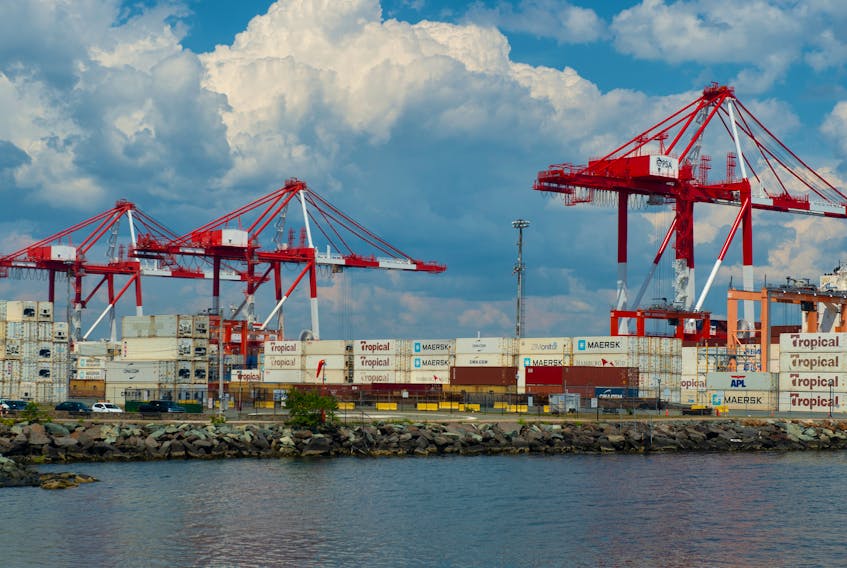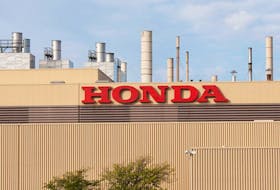MURRAY METHERALL
Business is booming at the Port of Halifax. Walls of containers stacked five high overshadow the port road. PSA Halifax Terminal looks to be bursting at the seams.
Overflow stacks of empty containers are parked anywhere there is room on the waterfront, on CN land and elsewhere. The proposed northern expansion of the south-end terminal, for which government infrastructure funding was applied for and not received, seems needed if not urgent.
“We’re busy. No doubt about it,” says Kevin Piper, local president for the Longshoreman’s Association.
Two ultra class container ships—the new gold standard for ports—arrive within a week, the biggest ships to ever call in Canada. A gaggle of gantry cranes, including one with a 24-container-span, descend on the CMA CGM Panam, direct from Colombo via Suez, at 7 a.m., an hour before longshoremen starting time.
Kevin Piper talks about pride in port productivity but it’s the stable workforce and lack of disruption that impresses importers like Neil McKenna of Canadian Tire, the Port of Halifax’s biggest.
Pier 41, the south-end container pier, has no navigation restrictions, is an hour from the pilot, near ocean trade routes, has 16 metre (52 foot) water depth dockside for ships up to 16,000 TEU, and with a pier extension will be soon able to handle two megaships simultaneously. In the quest for port efficiencies, there is a data driven website with truck waiting and container dwell times and a vessel forecast app for arrivals and departures.
Being competitive as a container ship “discretionary” destination (cargo does not have to come here) is tough. That means “Halifax has to up its game,” says HPA Media Relations’ Lane Farguson.
It appears to be doing just that, but so are competitors.
To open in 2024, a new deep-water container terminal is planned for the Port of Quebec built in partnership with CN. According to CN, the new terminal will be fully automated except for loading and unloading of vessels and be able to handle 700,000 TEUs a year. As in Halifax, plans call for berthing two ultra class vessels together.
CN, under President and CEO J.J. Ruest, is a longtime stakeholder in the Port of Halifax, as the sole rail provider inland. The Port of Halifax bills itself as a rail port having success and seeing potential growth in servicing central Canada and the American Midwest. But it already faces competition from American ports, others on Canada’s East Coast and the river portof Montreal. Soon it may have another, upgraded North American port closer to lucrative inland markets—Quebec City.
“It could be a threat,” says longshoreman Piper. “If you take 3,000 containers off in Halifax and need 1,500 rail cars to ship them inland, it is expensive. Compare that to the cost of diesel fuel to drive them 1,000 nautical miles through the Gulf and up-river, a little bit of cargo on an ultra-class ship.”
For CN, with a foot in each camp, it would seem CEO Ruest would want both Quebec and Halifax to prosper and for CN not to be competing with itself. Then where will all the containers come from to “feed the beast” that is CN’s rail capacity.
Part of the success of Prince Rupert, CN’s western container gateway, is due to it attracting a growing share of American cargo once bound for the US West Coast. Like Halifax on the East Coast, Prince Rupert is the first port of call for West Coast traffic from Asia as it lies to the west of Vancouver and competing American ports (Prince Rupert Port Authority). For Asia manufacturers shipping via the East Coast of North America, if time is a factor routing through Halifax is an advantage while the lower slot costs of ship transit versus rail could make Quebec or Montreal, or even New York a better choice.
Applying the Prince Rupert model, CN may be looking to fill capacity in Halifax and in Quebec by targeting container volumes now going through US ports on the Eastern Sea Board. Ruest said as much in a speech in January.
Since 2008 Canada’s market share of North American container traffic has dropped by 18 per cent, according to a recent Canadian Press report.
Rail costs are higher serving Midwest markets from Halifax rather than Quebec or Montreal but this can be offset partially by running bigger trains. What CN promotes on its Port of Quebec website applies as well to Halifax: “Big train capabilities (up to 14,000-foot trains) equals lower inland cost per TEU,” CN says.
Meanwhile, the Port of Halifax and its CEO Captain Alan Gray remain focused on growing the port and business every way they can. As reported in The Chronicle Herald in August, a new software system described as a “market research tool” will enhance the port’s competitiveness. Datamyne software enables the Halifax Port Authority to get intel on competing ports in the Northeast.
Halifax longshoremen and women are helping with more than their labour. The ILA Pension Plan, through the the Mid-West Cargo Rebate Agreement, provides an incentive for shippers that reduces the cost of getting containers from Halifax to U.S. markets.








